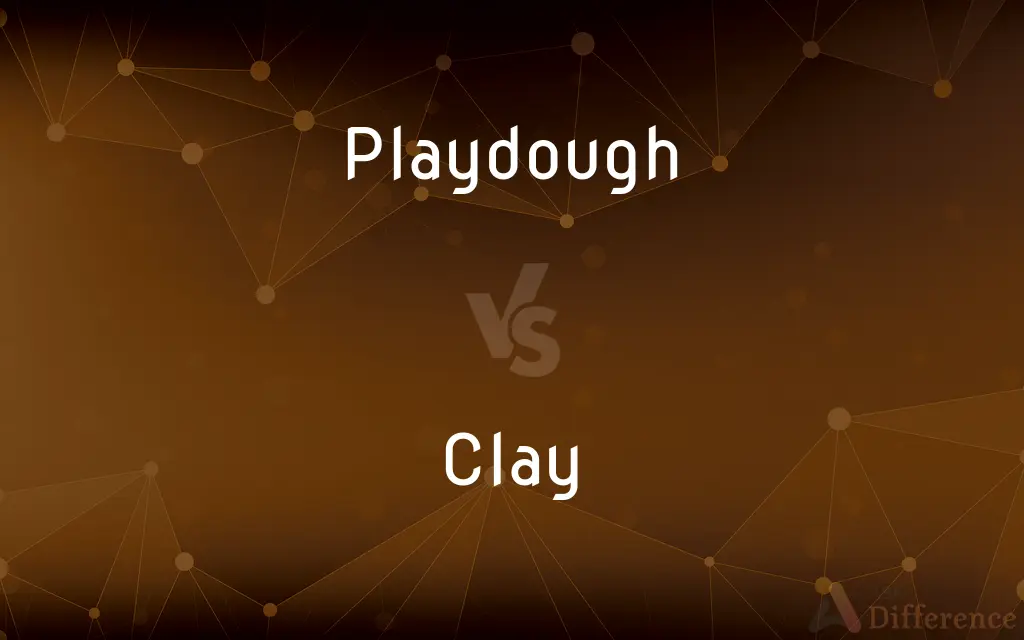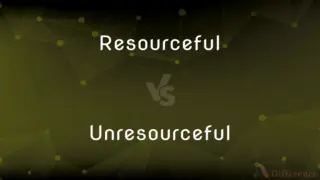Playdough vs. Clay — What's the Difference?
Edited by Tayyaba Rehman — By Maham Liaqat — Updated on March 31, 2024
Playdough is a soft, pliable modeling material used primarily by children for play, while clay is a natural earth material used for both artistic and practical purposes.

Difference Between Playdough and Clay
Table of Contents
ADVERTISEMENT
Key Differences
Playdough, a non-toxic, colorful modeling compound, is designed for safe play and educational use, allowing children to craft shapes and figures with ease. Whereas, clay, which can be found in natural settings or prepared for various uses, requires more skill to mold and is used in art, pottery, and sculpture, often requiring kiln firing to harden.
The composition of playdough is primarily flour, water, salt, boric acid, and mineral oil, making it soft and reusable but not suitable for permanent creations. Clay, on the other hand, is a natural substance composed of fine-grained minerals, and it becomes permanently hard when fired, making it ideal for creating lasting art pieces.
Playdough is known for its bright, vibrant colors and is often used in educational settings to enhance motor skills, creativity, and learning in children. Clay, while it can be colored, is usually found in natural tones and is favored by artists and craftspeople for its versatility and durability once fired.
The ease of use is a significant difference; playdough can be used straight out of the container with minimal preparation, making it ideal for young children. Clay requires kneading and sometimes a specific set of tools and techniques to shape and mold, along with a firing process for finishing, making it more suited to older children and adults.
Safety and cleanup are also considerations; playdough is non-toxic and easy to clean up, designed for unsupervised play. Clay, while also non-toxic, can be messy and requires supervision for young children, especially when tools or kilns are involved.
ADVERTISEMENT
Comparison Chart
Composition
Flour, water, salt, boric acid, mineral oil
Fine-grained natural minerals
Use
Educational play and crafting
Artistic creation, pottery, sculpture
Durability
Not durable, dries out, not for permanent use
Can be fired to become hard and durable
Colors
Bright and vibrant
Natural tones, though can be colored
Skill Level
Easy, suitable for young children
Requires skill and technique, for older users
Safety and Cleanup
Non-toxic, easy cleanup
Non-toxic but can be messy, requires supervision
Compare with Definitions
Playdough
Soft and easy to manipulate.
He squeezed and rolled the playdough effortlessly.
Clay
Used in professional and hobbyist pottery and sculpture.
The artist shaped a detailed vase from clay.
Playdough
Bright, engaging colors for sensory play.
The classroom was filled with colorful playdough creations.
Clay
Versatile in artistic applications.
They created both delicate figurines and sturdy dishes from clay.
Playdough
Promotes creativity without permanence.
The kids enjoyed remaking figures from playdough.
Clay
Requires firing for permanence.
The pottery class students fired their clay pots in a kiln.
Playdough
Air dries but not intended for durable crafts.
The playdough sculpture dried out and crumbled after a few days.
Clay
Natural material with a tactile feel.
She loved the earthy feel of clay in her hands.
Playdough
Ideal for young children's play.
She crafted a bright green playdough dragon.
Clay
Requires more advanced techniques.
Mastering clay sculpting took years of practice.
Playdough
Modeling clay for children.
Clay
Clay is a type of fine-grained natural soil material containing clay minerals. Clays develop plasticity when wet, due to a molecular film of water surrounding the clay particles, but become hard, brittle and non–plastic upon drying or firing.
Clay
A stiff, sticky fine-grained earth that can be moulded when wet, and is dried and baked to make bricks, pottery, and ceramics
A clay soil
A clay tile
The soil is mainly clay
The rocks are covered by various mixtures of loose clays and sands
Clay
A European moth with yellowish-brown wings.
Clay
A fine-grained, firm earthy material that is plastic when wet and hardens when heated, consisting primarily of hydrated silicates of aluminum and widely used in making bricks, tiles, and pottery.
Clay
A hardening or nonhardening material having a consistency similar to clay and used for modeling.
Clay
(Geology) A sedimentary material with grains smaller than 0.002 millimeter in diameter.
Clay
Moist sticky earth; mud.
Clay
The human body as opposed to the spirit.
Clay
A mineral substance made up of small crystals of silica and alumina, that is ductile when moist; the material of pre-fired ceramics.
Clay
An earth material with ductile qualities.
Clay
(tennis) A tennis court surface made of crushed stone, brick, shale, or other unbound mineral aggregate.
The French Open is played on clay.
Clay
(biblical) The material of the human body.
Clay
(geology) A particle less than 3.9 microns in diameter, following the Wentworth scale.
Clay
A clay pipe for smoking tobacco.
Clay
A clay pigeon.
We went shooting clays at the weekend.
Clay
(informal) Land or territory of a country or other political region, especially when subject to territorial claims
Danzig is rightfully German clay.
Clay
(transitive) To add clay to, to spread clay onto.
Clay
To purify using clay.
Clay
A soft earth, which is plastic, or may be molded with the hands, consisting of hydrous silicate of aluminium. It is the result of the wearing down and decomposition, in part, of rocks containing aluminous minerals, as granite. Lime, magnesia, oxide of iron, and other ingredients, are often present as impurities.
Clay
Earth in general, as representing the elementary particles of the human body; hence, the human body as formed from such particles.
I also am formed out of the clay.
The earth is covered thick with other clay,Which her own clay shall cover.
Clay
To cover or manure with clay.
Clay
To clarify by filtering through clay, as sugar.
Clay
A very fine-grained soil that is plastic when moist but hard when fired
Clay
Water soaked soil; soft wet earth
Clay
United States general who commanded United States forces in Europe from 1945 to 1949 and who oversaw the Berlin airlift (1897-1978)
Clay
United States politician responsible for the Missouri Compromise between free and slave states (1777-1852)
Clay
The dead body of a human being
Common Curiosities
Is playdough suitable for making permanent crafts?
No, playdough is not intended for permanent crafts; it dries out and is not durable.
Can clay colors be as bright as playdough?
While clay can be colored, playdough typically comes in brighter, more vibrant colors suitable for young children’s preferences.
Can clay be used by children?
Yes, clay can be used by children under supervision, especially older children interested in more advanced crafting.
What makes clay a more skilled material to work with?
Working with clay requires knowledge of molding techniques and often the use of a kiln, making it more suitable for skilled crafters and artists.
Is playdough easy to clean?
Yes, playdough is designed for easy cleanup, making it ideal for unsupervised child play.
Do you need to bake playdough to harden it?
Playdough isn’t designed to be baked and hardened like clay; it naturally dries out over time.
What are the main differences in the composition of playdough and clay?
Playdough is made with kitchen ingredients and is non-toxic for safe play, while clay is a natural mineral substance.
Why is clay preferred for artistic and practical creations?
Clay's durability after firing makes it suitable for creating both artistic sculptures and practical items like pottery.
Are there age restrictions for using playdough and clay?
Playdough is generally safe for all ages, while clay use is recommended for older children and adults due to the skill and supervision required.
How does the tactile experience differ between playdough and clay?
Playdough is soft and easy to manipulate, ideal for sensory play, while clay offers a more complex tactile experience, requiring kneading and shaping.
Share Your Discovery

Previous Comparison
Resourceful vs. Unresourceful
Next Comparison
Booking vs. BacklogAuthor Spotlight
Written by
Maham LiaqatEdited by
Tayyaba RehmanTayyaba Rehman is a distinguished writer, currently serving as a primary contributor to askdifference.com. As a researcher in semantics and etymology, Tayyaba's passion for the complexity of languages and their distinctions has found a perfect home on the platform. Tayyaba delves into the intricacies of language, distinguishing between commonly confused words and phrases, thereby providing clarity for readers worldwide.














































